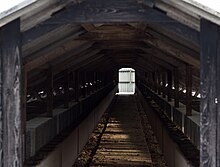Fur farm

A fur farm is a business that breeds fur animals for the purpose of obtaining fur for the manufacture of fur clothing and other fur products. Fur farms see themselves as agricultural livestock owners . Mainly minks , but also foxes , raccoon dogs , polecats , rabbits and chinchillas are bred.
Regulations
An “expert opinion on the humane keeping and killing of fur animals” from 1986 and the recommendation of the Council of Europe from 1999 were incorporated into national law. They included recommendations on housing, farming, health screening, research, killing methods and equipment; they spoke out against substances that could harm animals.
In Germany, there are legally binding provisions on keeping fur animals defined there, Section 3 of the Animal Products Trade Prohibition Act , after attempts were made to enforce stricter rules in the provisions of the Animal Welfare and Livestock Keeping Ordinance repealed by the Federal Constitutional Court . The term “fur farm” was and is not found there.
The fur breeders are represented in 16 countries by the European Fur Breeders Association (EFBA).
history
According to the German Animal Welfare Association, there were around 670 fur farms in the USA and around 6,000 in the EU (as of 2008). In Germany, the number fell from 2007, when there were still 30 fur farms, to seven farms in March 2017. Since 2019 there has been no mink farm in Germany. Denmark, Europe's largest mink producer, recorded 2100 (as of 2003), Sweden 140, Norway 600 and Finland 1700. 57.5% of the world's mink fur supply comes from European farms, the value approx. 1.5 billion euros. The most important buyer of European pelts is China (second largest mink fur supplier in the world).
Here the development for the fur country Canada 1930 to 1985:
| year | Mink fur | Farms | Fox skins | Farms |
|---|---|---|---|---|
| 1930 | 3,284 | 793 | 64,098 | 5,070 |
| 1940 | 229.202 | 3,284 | 190.198 | 6,282 |
| 1950 | 589.352 | 2,557 | 63,062 | 985 |
| 1960 | 1,203,853 | 1,616 | 2,034 | 76 |
| 1970 | 1,499,211 | 837 | 1,305 | 45 |
| 1980 | 1,213,684 | 621 | 10,348 | 377 |
| 1985 | 1,422,084 | 596 | 53,998 | 938 |
| 2009 | 2,500,000 | 820,000 |
Various European mink farms were also affected by the Covid-19 pandemic that occurred in 2020 . Individual farm workers and the animals were infected. Most of the farm animals were then killed as a precaution. In the Dutch parliament on June 23, 2020, some motions were made to stop the restart of the affected mink farms, to maintain a ban on the transport of minks as long as there is a risk of infection, and to provide a compensation plan for the mink breeders so that the exit from mink farming at the end of the year 2020 and not, as already decided, 2024.
criticism
Animal rights activists have long been calling for a worldwide ban on fur farms. Among other things, on the grounds that there is no longer any need for people to wear furs (and consequently kill animals for it), since high-quality faux fur articles are now being produced. The fact that people wear fur for reasons of prestige and that living beings would have to die for it is also part of the argumentation of animal rights activists.
It is also criticized that animals are kept in cages that are many times smaller than the animals' natural roaming areas. In the case of minks, for example, around ten million times as much . In the wild, mink, raccoon dogs and foxes would avoid their conspecifics over a large area and claim large territories for themselves, running, climbing, swimming and looking for food. In the past, conditions were often found on fur farms in which the animals had to vegetate closely packed in their cages until they died. Many animal rights organizations, including ARIWA and PETA , criticize fur farming.
See also
Individual evidence
- ↑ See: Regulations for keeping fur animals ( Memento of the original from October 10, 2006 in the Internet Archive ) Info: The archive link has been inserted automatically and has not yet been checked. Please check the original and archive link according to the instructions and then remove this notice.
- ↑ Archived copy ( Memento of the original dated November 4, 2006 in the Internet Archive ) Info: The archive link was inserted automatically and has not yet been checked. Please check the original and archive link according to the instructions and then remove this notice.
- ↑ https://www.tierschutzbund.de/pelztierfarmen.html , accessed on March 23, 2017.
- ↑ fur market 3: EFBA - European Fur Breeders' Association (Association of European Fur Breeders). German fur association V., December 2008
- ^ Christian Franke / Johanna Kroll: Jury Fränkel's Rauchwaren-Handbuch 1988/89. 10. revised and supplemented new edition, Rifra-Verlag Murrhardt, p. 80
- ↑ Oslo Fur Auction. Secondary source: Archived copy ( memento of the original from November 22, 2011 in the Internet Archive ) Info: The archive link was inserted automatically and has not yet been checked. Please check the original and archive link according to the instructions and then remove this notice. Fur market 5/10
- ↑ Covid-19 and a Spanish mink farm. - Covid-19 and the Danish mink farms . In: '' Pelzmarkt - Newsletter of the German Fur Association . August 2020, p. 10.
- ↑ Mink and Covid-19 . In: '' Pelzmarkt - Newsletter of the German Fur Association . July 2020, p. 4.
- ^ Van Putten, in: Fölsch / Napholz, Ethological statements on animal welfare, 1982, p. 78ff
- ↑ Jürgen Foss: Fur. In: www.ariwa.org. Retrieved November 6, 2016 .


